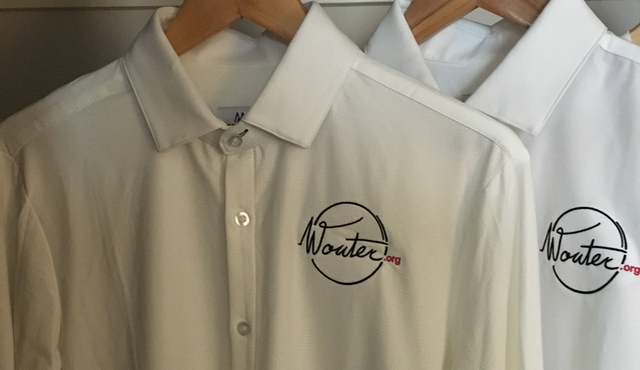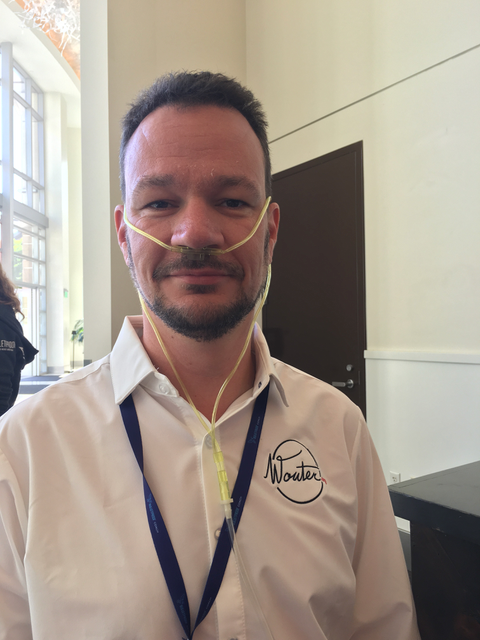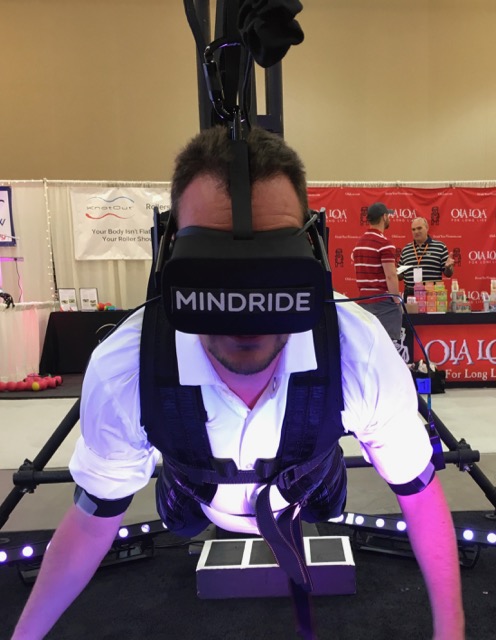My takeaway
“Lief” has a very interesting kinesthetic approach to HRV training, leading to faster unconsciously-competent management of your own activation level. This technology might go places.
I also see some exciting possibilities with this technology to deepen authentic relating.
There is a lot to experiment with and figure out before I come to a clear conclusion, so I am writing this so you can get a sense of what is happening.
What is “Lief”?
“Lief” is a wearable heart rate variability (HRV) tracker and feedback device. It is smaller than my palm, has a shape that reminds me of a liver (probably because it attaches to your ribs under the breast).
It has two connectors for adhesive sensor pads, similar to EKG pads that stick to your skin. According to the guys of “Lief”, the pads can stay attached for 1-2 days and are standard in the field of heart rate sensing (so you are not locked in to buying them from Lief if you chose “Lief” as a tool).
Besides the electrical sensors for the heart rate, the Lief also has built in acceleration sensors (which it uses for detecting breathing rate and hence faster and more accurate HRV coherence determination), and a vibration motor. It also has a Bluetooth® Low Energy (BLE) link to the accompanying app on iPhone/Android, and a fairly sizable USB-rechargeable battery (1+ day with feedback mode, 4+ days with measuring according to the guys from Lief Therapeutics).
What makes Lief different?
What makes the Lief different from other heart rate sensors, is the mode where it uses tactile feedback (the vibration motor) to provide the wearer with the HRV feedback. The Lief vibrates gently when it estimates that your exhale would maximize the downslope of HRV, i.e. helps you shift your body into a less reactive mode.
In practice, this means that the “Lief” vibrates gently in a pattern that feels much like a breath. This feedback loop feels much more body-based than say, the sounds or visual indicators of the Inner Balance or the Muse headband.
Traditional HRV feedback
The traditional HRV feedback cycle is:
- The heart-rate sensor detects that the HRV coherence is low (anxiety).
- The app shows or sounds a warning (requiring you to watch a screen or listen)
- Based on that information, you have to know how to change your brain state (letting the thoughts go for example, or focussing on your breathing again).
- After a while the brain state influences your breathing/heart rate, and the HRV coherence is high (relaxed).
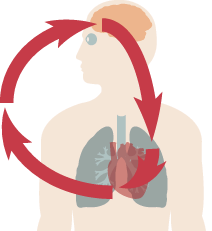
As a result, there is an extra brain-heavy step in this process, and a bit more lag between notification and the change in attention/behavior. The advantage is that your brain learns to quiet itself and your body. The disadvantage is that your brain is in the loop.
Lief feedback cycle
With the Lief, the cycle now is:
- HRV coherence is low (anxiety).
- Lief reminds body to breathe in the way that restores HRV coherence.
- HRV coherence is high (relaxed).
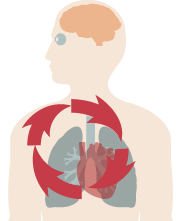
With the Lief, obviously your brain is still actually in the loop, but in the background. As the feedback is more kinesthetic, a somatic experience, I imagine it will be easier to learn to automatically moderate your physical state.
(Also, because the Lief also can determine the breathing rhythm, it will calculate the HRV coherence more correctly faster, ending in a shorter-in-time feedback cycle too.)
Lief’s kinesthetic approach worked for me
I seem to generally have a fairly regular and deep breathing pattern (as detected with the Spire), and I think I unconsciously-competently(?) regulate my HRV that way. Even so, after a few minutes of attuning myself to the vibration/feedback of the Lief (which was fairly easy for me), I did feel myself slow down in the hectic tech hall of the Bulletproof Conference.
I like this kinesthetic feedback loop. I think this somatic feedback will indeed make learning to modulate the level of nervous system activation much easier, creating the calming effects of meditation minimizing the involvement of the brain.
Their application area
From the developers perspective, the aim for “Lief” is to become more aware of stress/anxiety in your body, and teach your body to relax (i.e. have better HRV coherence).
One of the developers shared that it helped him overcome social anxiety. I can see how this would be a very useful tool for those of you struggling to notice anxiety and bodily activation early.
My application area: what I’m excited to use it for!
In Authentic Relating, we have developed simple yet powerful practices to drop deep into connection with others. In doing those practices, especially the ‘Circling’ practice that brings this many skills together, I often get a sense of feeling the other person deeply and more rarely, a sense of us merging. I feel as if we are going into a “we-space”.
Yes, I know, this may sound quite woo-woo. This “we-space” might be a pure imagination (I don’t think so), this may be mirror-neurons / the vagal nerve in action (my current best theory), some non-dual energy experience in action, or pure randomness. All I know, is that I have a strong subjective experience of this.
So I’ve been very curious to see if this very subjective feeling may actually be supported by “objective” measurements. Nothing like n=1 experimentation, especially when it touches such a subjective and personal experience.
The guys of “Lief” were very enthusiastic about such an experiment and in no time both Cris (close friend and fellow experienced practitioner of Authentic Relating practices) and I got a pre-production Lief device attached to us.
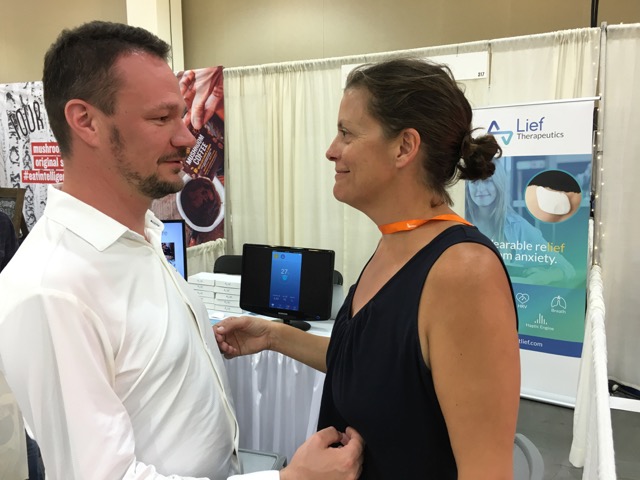
First impressions from this experiment
We experimented with the Lief as a way to connect to ourselves first, then moved to connecting to another. We got interesting preliminary results.
Stronger connection to self
During our trials of the authentic relating practices (Notice Imagine Feel and Numbers), the vibrating of the Lief seemed to help anchor me into my body. I see this as having benefits and a disadvantage:
+ I can see the “Lief” helping me to feel more of my own state, and ground into my own state more. So it is easier to be with my own bodily experience.
+ As a result, I also felt more anchored in my body, so it seems easier not to lose myself in the other.
– It also seems harder to lose myself in the other person. Putting my attention almost completely on the other person seems much harder because I was ‘dragged’ back to myself.
Not clear how it helps make connection to other
After just focussing on our own “Lief”, and getting in the flow of the practices, we tried out consciously synching our HRV downslopes with each other (as shown in the picture). My hypothesis was that by consciously synching our HRV downslopes, we might get more easily in a we-space.
Testing my above hypothesis was not successful (so far). There were some demonstration-effect technical glitches, that may have been in the way also. We did not get both Liefs in the same downslope mode until late in this experiment, and one of our Liefs was not linked to a phone so we could not modify its settings nor read the values easily.
I’m not coming to any definitive conclusions from this experiment about this device, as I know from experience, that these kind of glitches happen with spontaneous experiments.
We were also doing this in a context of a loud, bustling technical hall, and I did have less sleep than I would like to have had.
I’ll experiment with this tool more, but I don’t think this path of consciously physically syncing of breathing/HRV will work. The natural breathing and hence HRV coherence of participants will likely be too different.
A way to sync the HRV coherence level could possibly help, and might supercharge what happens in the authentic relating practices already.
This might make “connection to other” measurable?
After attempting to attune and create coherence via our respective Liefs first, we tried the Numbers authentic relating game. That too did not seem to work because of a practical aspect of the Numbers game: the person repeating the numbers aims to speak the number very close to the original speaker. This means that the repeater has to hold their breath to have enough air to say the number when the original speaker says it.
This holding your breath “unnaturally” of course brings your HRV out of coherence.
So we shifted to Notice Imagine Feel, a practice that also connects to another person, but allows each individual to have their own rhythm in speaking (and hence probably more natural breathing pattern and hence more HRV coherence).
After doing that for a few back-and-forths, we did seem to get into a resonant HRV pattern for a while: the other’s Lief vibrated at the same time, suggesting that the breathing had synchronised with maximised HRV coherence.
Further experiments needed 🙂
My cautious impression, is that using this kind of tool might help with authentic relating:
- Connection to self seems it might to be faster, and possibly deeper and more easily sustained during the process: The Lief gives subtle somatic assistance to stay in HRV coherence.
- Connection to the other might be supported, especially in online settings, by helping noticing dissonance between coherence states. I need to experiment a bit more with two Liefs to get a better feel for it.
- We-space – I hope it might be in a way, measurable with these sensors. Just how the HRV coherence and the heart rates converge or differ might be a really interesting way to quantify this.
We, as well as the guys at Lief, enjoyed the experiment we did in the tech hall, and want to try it with the practitioners in Boulder at the Integral Center. As the production run of the Liefs will be end of this year, the guys at “Lief” enthusiastically offered to loan me two of the pre-production models for that experiment in the meantime! I’m really looking forward to seeing what that will bring.
My intent is to hook up both the facilitator (Circler) and the focus of the Circle (Circlee) with Liefs, and see if we can actually see patterns of resonance or reaction between them both.
I’m arranging other sensors to also measure other aspects (2 Muses for brainwave measurement for example), as well as recording video and audio.
All in all I had a very fun time mixing authentic relating and biohacking technology, and am very much looking forward to trying this more.
With a beating heart,
Wouter
P.S. “Lief”: what is in a name?
By the way, according to the founders, the name “Lief” is both an abbreviation of “relief” (from anxiety, stress etc) and of the old English word “lief” meaning “beloved” or “willing”.
In Dutch, “lief” means “nice, lovely” as adjective, and “my beloved” as noun. I prefer that interpretation 🙂


